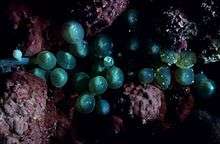Caulerpa
Caulerpa is a genus of seaweeds in the family Caulerpaceae (among the green algae). They are unusual because they consist of only one cell with many nuclei, making them among the biggest single cells in the world. A species in the Mediterranean can have a stolon more than 3 metres (9.8 ft) long, with up to 200 fronds. This species can be invasive from time to time.
| Caulerpa | |
|---|---|
| Caulerpa prolifera | |
| Scientific classification | |
| Phylum: | Chlorophyta |
| Class: | Ulvophyceae |
| Order: | Bryopsidales |
| Family: | Caulerpaceae |
| Genus: | Caulerpa J.V. Lamouroux, 1809 |
| Type species | |
| Caulerpa prolifera (Forsskål) J.V. Lamouroux, 1809 [1] | |
| Species[2] | |
|
About 86 | |
Referring to its thalli's crawling habit, the name means 'stem (that) creeps', from the Ancient Greek kaulos (καυλός, ‘stalk’) and herpo (ἕρπω, ‘to creep’).[3]
Food use
Some species (especially Caulerpa lentillifera and C. racemosa) are eaten under the names "green caviar", or "sea grapes" (海葡萄, umi-budō) in Okinawa. They have a peppery taste.
Sea grapes are also eaten in Indonesian cuisine, sometimes fresh, and other times coated in sugar. In the Philippines, sea grapes are raised in the Catanduanes and Cebu provinces for domestic consumption in the Philippines as well as for export to Japan.
Invasive behaviour
Another species, Caulerpa taxifolia, has become an invasive species in the Mediterranean Sea, Australia and southern California (where it has since been eradicated). In U.S. waters, the Mediterranean strain of Caulerpa taxifolia is listed as a federal noxious weed, under the Plant Protection Act. The Aquatic Nuisance Species Taskforce has also created a National Management Plan for the Genus Caulerpa. The state of California also prohibits possession of nine different species of Caulerpa.
It is thought that Caulerpa species have such invasive properties in these regions due to their capability to thrive in temperate waters, along with their freedom from natural predators. Most Caulerpa species evolved in tropical waters, where herbivores have immunity to toxic compounds within the alga. Temperate water herbivores have no natural immunity to these toxins, allowing Caulerpa to grow unchecked if introduced to temperate waters.
C. racemosa has recently been found in waters around Crete, where it is thought to have contributed to a significant reduction in fisheries. The alga has invaded the area from the warmer waters of the Red Sea.
C. cylindracea, which is native to Australia, has also become an invasive species in the Mediterranean.[4]
Use in aquariums
Caulerpa is common in the aquarium hobby as a nitrate absorber because of its rapid growth under relatively adverse conditions. It may also be used in refugiums for a long-term nitrite absorber. Many introductions of invasive Caulerpa to the wild are thought to have occurred via aquarium dumping although there is no proof that this is so. For this reason, some aquarium hobbyists have begun using Chaetomorpha or an algae scrubber instead.[5][6]
Species


The species currently recognized are:[1]
- Caulerpa agardhii
- Caulerpa alternans
- Caulerpa annulata
- Caulerpa antoensis
- Caulerpa articulata
- Caulerpa ashmeadii
- Caulerpa bartoniae
- Caulerpa bikinensis
- Caulerpa biserrulata
- Caulerpa brachypus
- Caulerpa brownii
- Caulerpa buginensis
- Caulerpa cactoides
- Caulerpa carruthersii
- Caulerpa chemnitzia
- Caulerpa cliftonii
- Caulerpa constricta
- Caulerpa corynephora
- Caulerpa crassifolia
- Caulerpa cupressoides
- Caulerpa cylindracea
- Caulerpa delicatula
- Caulerpa dichotoma
- Caulerpa diligulata
- Caulerpa distichophylla
- Caulerpa ellistoniae
- Caulerpa elongata
- Caulerpa falcifolia
- Caulerpa faridii
- Caulerpa fastigiata
- Caulerpa fergusonii
- Caulerpa filicoides
- Caulerpa filiformis
- Caulerpa flexilis
- Caulerpa floridana
- Caulerpa harveyi
- Caulerpa hedleyi
- Caulerpa heterophylla
- Caulerpa holmesiana
- Caulerpa imbricata
- Caulerpa juniperoides
- Caulerpa kempfii
- Caulerpa lagara
- Caulerpa lamourouxii
- Caulerpa lanuginosa
- Caulerpa lentillifera
- Caulerpa lessonii
- Caulerpa longifolia
- Caulerpa macrodisca
- Caulerpa macrophysa
- Caulerpa manorensis
- Caulerpa matsueana
- Caulerpa mexicana
- Caulerpa microphysa
- Caulerpa murrayi
- Caulerpa nummularia
- Caulerpa obscura
- Caulerpa okamurae
- Caulerpa oligophylla
- Caulerpa ollivieri
- Caulerpa opposita
- Caulerpa papillosa
- Caulerpa parvifolia
- Caulerpa parvula
- Caulerpa paspaloides
- Caulerpa peltata
- Caulerpa pickeringii
- Caulerpa pinnata
- Caulerpa plumulifera
- Caulerpa prolifera
- Caulerpa pusilla
- Caulerpa qureshii
- Caulerpa racemosa
- Caulerpa remotifolia
- Caulerpa reniformis
- Caulerpa reyesii
- Caulerpa scalpelliformis
- Caulerpa sedoides
- Caulerpa selago
- Caulerpa serrulata
- Caulerpa sertularioides
- Caulerpa seuratii
- Caulerpa simpliciuscula
- Caulerpa spathulata
- Caulerpa subserrata
- Caulerpa taxifolia
- Caulerpa trifaria
- Caulerpa urvilleana
- Caulerpa vanbossea
- Caulerpa veravalensis
- Caulerpa verticillata
- Caulerpa vesiculifera
- Caulerpa webbiana
- Caulerpa zeyheri
References
- Caulerpa J.V. Lamouroux, 1809 World Register of Marine Species. Retrieved 2011-08-20
- Guiry, M.D.; Guiry, G.M. (2007). "Genus: Caulerpa taxonomy browser". AlgaeBase version 4.2 World-wide electronic publication, National University of Ireland, Galway. Retrieved 2007-09-23.
- Bold, Harold Charles; Wynne, Michael James (1985). Introduction to the algae. Prentice-Hall. p. 229.
- Montefalcone, Monica; Morri, Carla; Parravicini, Valeriano; Bianchi, Carlo Nike (26 May 2015). "A tale of two invaders: divergent spreading kinetics of the alien green algae Caulerpa taxifolia and Caulerpa cylindracea". Biological Invasions. 17 (9): 2717–2728. doi:10.1007/s10530-015-0908-1.
- Nutrient Cycling In The Great Barrier Reef Aquarium. Proceedings of the 6th International Coral Reef Symposium, Australia, 1988, Vol. 2
- Reef Invertebrates, 2003, page 46
Further reading
- Jacobs, William P. (December 1994). "Caulerpa". Scientific American. 271 (6): 66–71.
External links
| Wikispecies has information related to Caulerpa |
- Food and Agriculture Organization - Seaweeds used as human food
- ITIS report
- Largest Single Cell
- CISR: Caulerpa taxifolia or Killer Alga Center for Invasive Species Research page on Caulerpa taxifolia and Killer Alga
- Caulerpa.com Blog